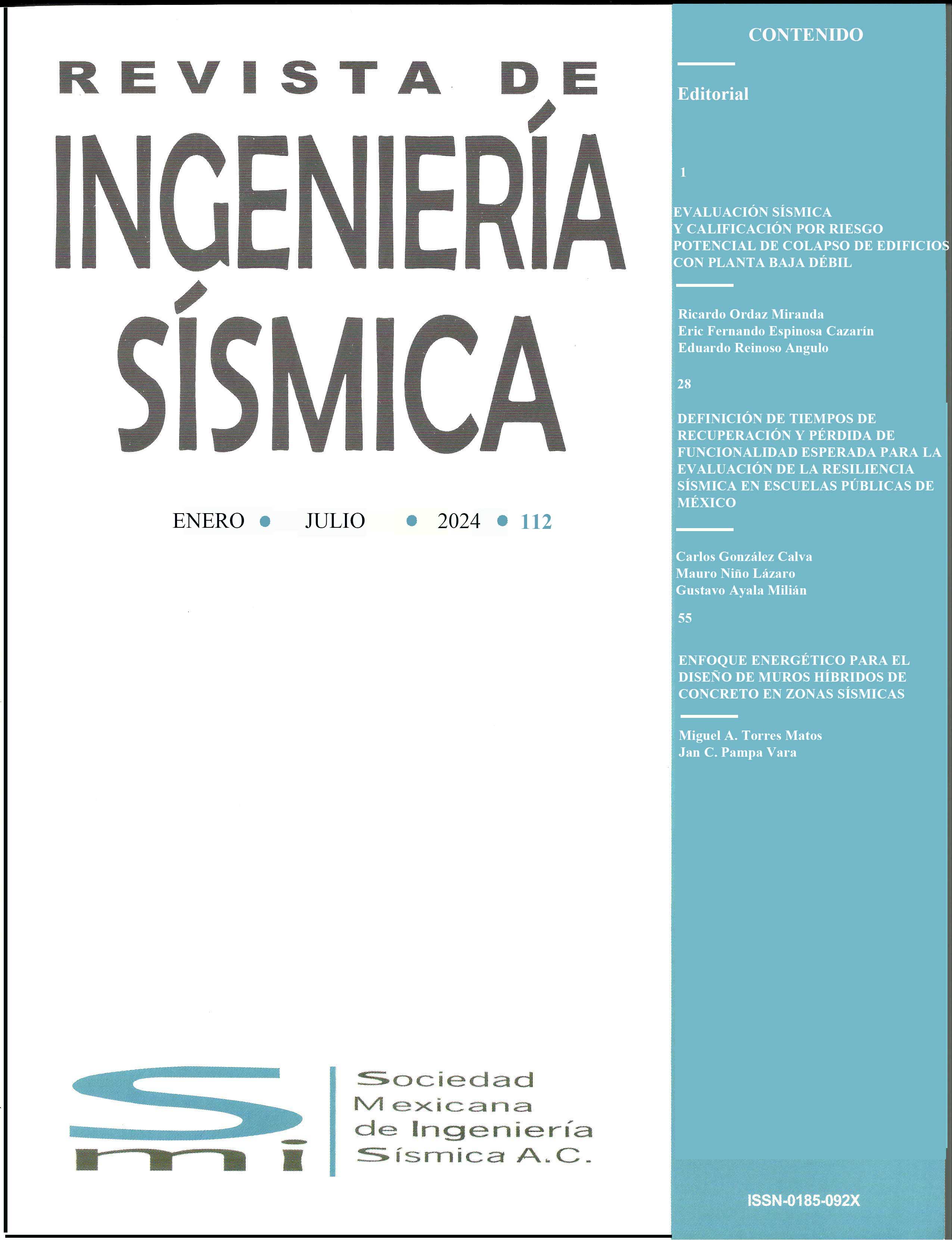ENSAYES SÍSMICOS EN MESA VIBRADORA DE UN EDIFICIO MINIATURA DE 5 NIVELES CON AISLADORES DE BASE
DOI:
https://doi.org/10.18867/ris.105.559Keywords:
shaking table, friction pendulum isolators; interstory drift; floor accelerations; seismic damageAbstract
Shaking table tests were conducted in previous research at the National University of Mexico (UNAM) on a miniature steel building named EM2, using a strong ground motion record. This building represented a conventional building. This paper describes the results of a second test unit called EM2-I, tested in the same shaking table with the same ground motion used in the test of EM2. The test unit with isolators, EM2-I, had a superstructure identical to that of the test unit EM2 but with base isolators of double friction pendulum type. Measured maximum interstory drifts were equal to 5.3% and 0.97% for test units EM2 and EM2-I, respectively. Measured maximum global drift was equal to 4% and 0.63% for test units EM2 and EM2-I, respectively. The maximum seismic coefficient measured in the isolated superstructure was equal to 26 % of the maximum value for this parameter measured in test unit EM2. Implications of the results in this research are discussed in this paper, showing the importance of using isolated structures as an efficient solution for resisting strong earthquakes and capable of immediate occupancy.
Downloads
References
Applied Tecnology Council (ATC), (2017), “Seismic Analysis, Design, and Installation of Nonstructural Components and Systems- Background and Recommendations for Future Work, NIST GCR 17-917-44. https://doi.org/10.6028/NIST.GCR 17-917-44.
ASCE/SEI 7-16 (2017), “Minimum design loads and associated criteria for buildings and other structures”, American Society of Civil Engineers, Structural Engineering Institute.
Blandón, J y Rodríguez, M (2007), “Estudio analítico-experimental y propuesta de diseño sísmico de sistemas de pisos rígidos en edificios”, Series de Investigación y Desarrollo, SID/656, Instituto de Ingeniería, UNAM.
Carr, A (1998), “Ruaumoko 2D”, Computer Program Library, Universidad de Canterbury, Departamento de Ingeniería Civil.
Comisión Federal de Electricidad, Instituto de Investigaciones Eléctricas, (2015), “Manual de Diseño de Obras Civiles, Diseño por Sismo”, Capítulo C.1.3: Diseño por Sismo.
Computers and Structures, Inc. (1984-2016), “ETABS 2016 Integrated Building Design Software”, Computers and Structures, Berkeley, California, EUA.
Constantinou, M, Mokha, A y Reinhorn, A M (1990), “Teflon Bearings in Base Isolation II: Modeling”, Journal of Structural Engineering, ASCE, Vol 116, Issue 2.
EN 15129 (2009), “European Standard Anti-seismic Devices”, Commitee for Standardization (CEN).
McVitty, W J y Constantinou, M C (2015), “Property Modification Factors for Seismic Isolators: Design Guidance for Buildings”, Technical Report MCEER-15-0005.
Naeim, F y Kelly, J (1999), “Design of Seismic Isolated Structures”, John Wiley & Sons, INC. New York.
NTCS-2017, Norma Técnica Complementaria por Sismo (2017). Gaceta oficial de la Ciudad de México.
Skinner, R I, Robinson, W H y McVerry, G H (1993), “An Introduction to Seismic Isolation”, John Wiley and Sons Ltd, Baffins Lane, Chichester, England.
Ordaz, M y Montoya, C (2012), “DEGTRA ver. 9.1”, Instituto de Ingeniería, UNAM.
Ponzo, F C, Di Cesare, A, Nigro, D, Simonetti, M y Lecceses, G (2014), “Shaking table tests of a base isolated structure with doublé concave friction pendulums”, New Zealand Society for Earthquake Engineering, Conference.
Restrepo, JI, Rodriguez, M, Kao-Stocker, G, Carr, AJ (2014), “Seismic Response of a Four-Story Miniature Building with Replaceable Plastic Hinges”, Journal of Earthquake Engineering, 18:8, 1217-1240
Rodríguez, M E (2020), Zenodo: http://doi.org/10.5281/zenodo.3606726
U.S. Geological Survey (1996), “USGS Response to an Urban Earthquake: Northridge '94”, Federal Emergency Management Agency (FEMA).






